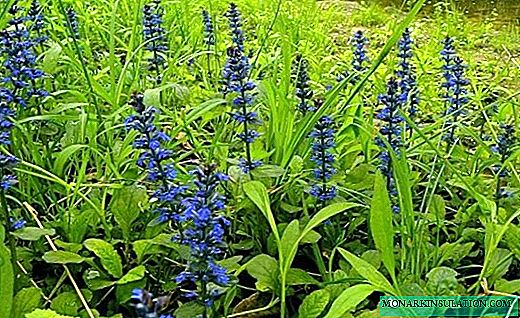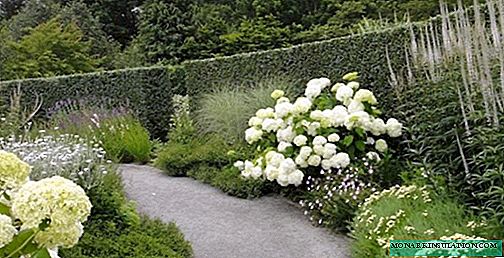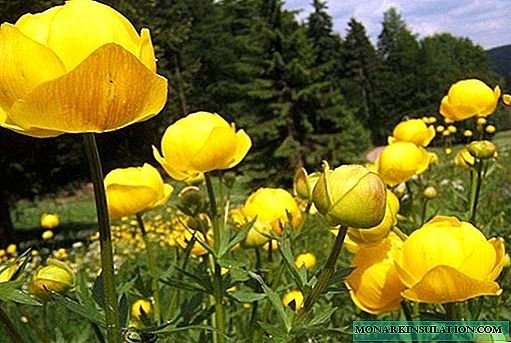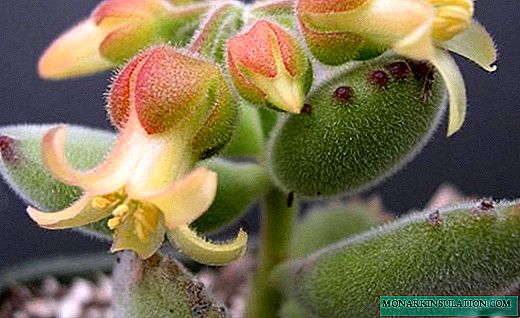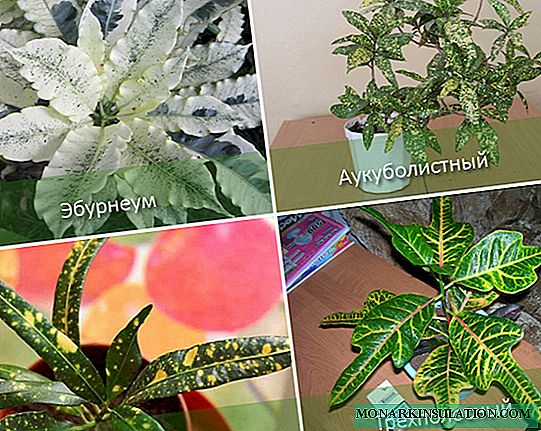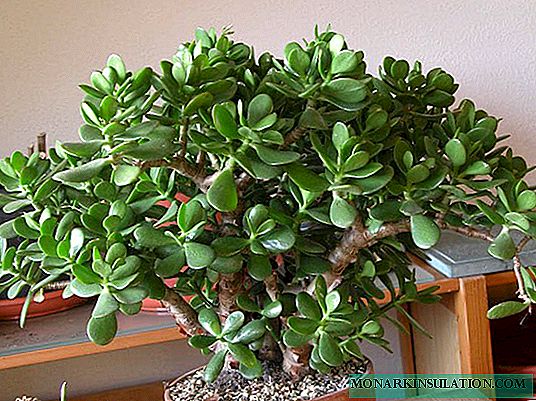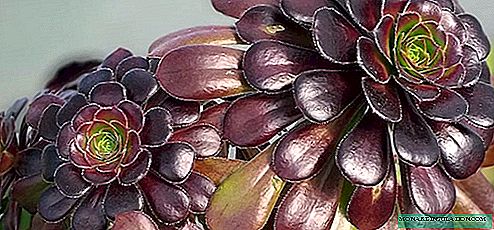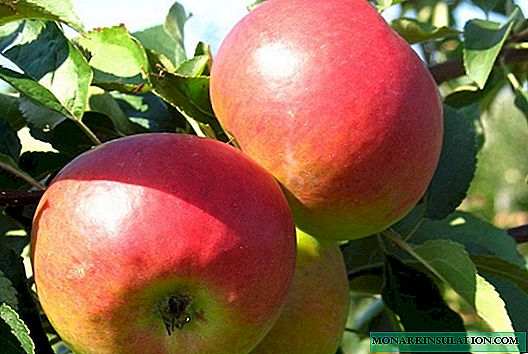
Apple-tree Zhigulevskoye is a long-known and popular variety in Russia. Those who are not familiar with it will be interesting and useful to learn about its positive aspects, as well as the disadvantages of this variety. We will tell you where and how to grow this attractive apple tree, how and when to use the crop.
Description of apple variety Zhigulevskoe
This late autumn table variety was bred in 1936 at the Kuibyshev experimental gardening station by crossing two varieties - the old Russian Borovinka and American Wagner (the variety owes it insufficient frost resistance). Since 1949, it was in state variety testing, and in 1965 it was registered in the State Register and zoned in six regions:
- Central;
- Central Black Earth;
- North Caucasian;
- Middle Volzhsky;
- Lower Volzhsky;
- East Siberian (in stlan form).
The variety is widespread in the middle lane. It has the following properties:
- A tree of medium or high growth, fast growing. The crown is translucent, relatively rare, broadly pyramidal, sometimes round. Generative kidneys are laid on twigs and coils.
- The shoots are quite thick, straight, dark brown.
- Pobegoobrazovanie low.
- It blooms early, because of which the risk of damage to the fruit buds by return frosts is not ruled out.
- The winter hardiness of the variety is insufficient.
- According to the State Register, the leaves are very affected by scab, the fruits are weak. But VNIISPK (All-Russian Research Institute for Selection of Fruit Crops) declares immunity to scab and severe defeat by the second generation of the apple moth.
- Early maturity. Fruiting begins 5-6 years after vaccination on a stock and planting in the garden.
- About the autonomy of the variety, information was not found in official sources. Some other sources report Zhigulevsky’s self-sterility and recommend that pollinator varieties be planted for him:
- Kuibyshevskoe;
- Anise gray;
- Antonovka is ordinary;
- Spartacus;
- Kutuzovets and others.
- Productivity is high. An adult tree brings in a successful year 200-250 kg of apples. At a young age, fruiting is annual, and with age it becomes partially periodic.
- Fruits of a very attractive form have the following characteristics:
- Large sizes - the average apple weighs 120-200 g, and individual specimens reach 350 g.
- The shape is round, flattened, sometimes with small rusted tubercles.
- The skin is smooth, strong. The main color is yellow with a bright carmine-red striped blush that covers almost the entire surface of the apple. And also there are many whitish, subtle subcutaneous points.
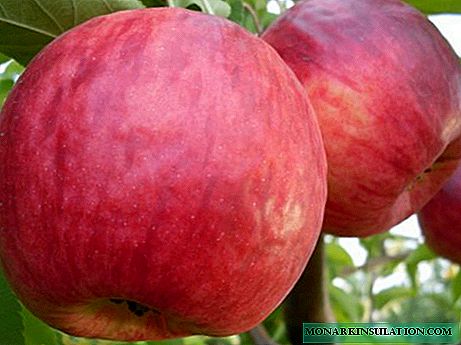
Individual copies of apples of the Zhigulevskoye variety reach 350 g
- The pulp is juicy, dense, tender. It has a cream color, good sweet and sour taste and a characteristic rich aroma.
- Removable maturity occurs in late August - early September. Fruits reach full maturity 2-3 weeks after harvest. Apples are stored and consumed for two to three months until December (sometimes until January).
Table: characteristic of the Zhigulevskoe apple tree depending on the type of stock
| Type of stock | Tree height | Fruit bearing date | Landing interval, meters | Features |
| Seminal | Above 4 meters | 6-7 years old | 4-5 | Requires restraining pruning |
| Medium | 3-4 m | 4-5 years old | 3-4 | |
| Semi-dwarf | 3m | 3-4 years | 2,5-3 | Ages quickly, requires rejuvenation |
| Dwarf | 2 m | 1,5-2 | Needs support (trellis) |
Landing
Zhigulevskoe apple seedlings are planted according to the rules usual for this culture. There are no features in this process required by the variety. Therefore, just briefly and step by step we remind novice gardeners the order of planting an apple tree:
- Choose a landing time. For southern regions with warm winters and hot summers, the planting period is preferable in late autumn - after the end of sap flow (when the leaves fall) and the plant goes to rest. But before the onset of frost, 3-4 weeks should still remain. In cold areas, trees are planted in early spring, when the plants have not yet awakened and have not grown.
- Find the optimal place for the future apple tree. It must meet the following requirements:
- Located on a small south or southwest slope without stagnation of water. The depth of groundwater is allowed at least 2-3 meters.
- Categorically lowlands, ravines and similar places in which cold air may stagnate are not suitable.
- It is advisable to have natural protection against cold northerly winds in the form of a fence, thick trees, the walls of the building. If this is not possible, then for the first time young plants should build such protection by installing shields knocked down from bars and plywood. You can also cover plants for the winter with a spanbond.
- The soil should have a loose structure and have neutral acidity. The optimal pH is 6.5-7.
- Two to three weeks before planting, a landing pit is prepared. In the case of spring planting, a pit is prepared in late autumn. For this:
- Dig a hole 0.7-0.8 m deep and 0.8-1 m in diameter.
- Crushed stone, gravel, expanded clay and the like materials for arranging a drainage layer are laid at the bottom. Its thickness is 10-15 cm.
- They fill the pit with fertile soil, prepared by mixing black soil, peat, humus and sand, taken in equal quantities.
- On the day of planting, the roots of the seedling are soaked in water for 3-4 hours.
- In the center of the landing pit, a hole of such dimensions is prepared that the roots of the seedling fit in it, and form a small mound in it.
- The seedling is lowered into the hole so that its root neck rests on the top of the knoll, and the roots are spread on the slopes.
- They fill the hole with the soil removed from it, carefully compacting it. During planting, make sure that the root neck is ultimately at ground level or slightly raised (3-4 cm).

Make sure that the root neck of the seedling does not deepen
- Around the seedlings, an earthen roller is raked along the diameter of the pit to retain water during irrigation.
- Water the plant with plenty of water until the trunk circle is completely filled. After the water is absorbed, the procedure is repeated another 1-2 times. This contributes to a good fit of the soil to the roots and, as a result, better survival.
- They fill the soil with a layer of mulch (in its quality you can use humus, peat, rotted sawdust, etc.) with a thickness of 5-10 cm.
- Cut the top of the seedling at a height of 0.8-1 m from the ground. If there are branches, then they need to be cut in half.

After planting, cut off the top of the seedling at a height of 0.8-1 m from the ground
Features of cultivation and subtleties of care
Like planting, caring for an apple Zhigulevskoye does not differ in any way. It is generally unpretentious, but when growing it should pay more attention to two aspects.
Crown formation
Since the variety has a fairly large growth force, they form an apple tree on a seed or mid-root stock using a sparse-tier scheme with growth retardation. Such a formation has long been known and mastered by most gardeners.
Apple trees on dwarf and semi-dwarf rootstocks, which are grown on trellises, form as palmettes or spindles.
In the harsh conditions of Siberia, the stanled formation of the crown of the apple tree is used.
Photo Gallery: Apple Tree Formation Schemes

- Sparse-tier crown formation is used for tall trees

- Apple trees on dwarf rootstocks form in the form of palmettes for growing on trellises
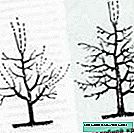
- Spindle-shaped formation suitable for low and medium-sized apple trees

- Crown shaping is used in harsh regions
Shelter from frost
Low frost resistance of the variety makes it necessary for gardeners in cold regions to apply additional measures to protect plants from frost. If the apple tree is grown in stlan form, then for the winter it is quite easy to cover it with snow, lapnik, fallen leaves or covering material. Low-growing trees can be wrapped with a spanbond, pre-bonded branches or made for them special frames and cover material already pull on them.

Low-growing trees can be wrapped with a spanbond, having previously connected the branches
Another possibility to protect the stamb from freezing is that before planting the apple tree is grafted onto a frost-resistant rootstock at such a height that the grafting site is higher than the snow level typical of the region.
Diseases and pests - prevention and control
Given the conflicting information about the immunity of the variety to diseases and pests, it is worth at least regularly performing traditional preventive measures:
- In autumn, you need to rake all the fallen leaves and burn if there is a suspicion of their infection. If there is no such danger, then the leaves can be used to shelter trees or tree trunks.
- After collecting the leaves, they deeply dig the soil around the trees with a flip of layers. If you do this just before the onset of frost, then pests and pathogens raised in the soil that winter in the soil will die from the cold.
- At the same time, trunks and thick shoots are bleached with lime mortar or special garden paints. This will prevent tree bark from sunburn and frost.
- In early spring, when the buds are not yet swollen, an eradicating treatment with potent pesticides should be carried out. DNOC, Nitrafen, 5% solution of copper sulfate are usually used.
In case of detection of the scab declared in the description of the State Register, treatment with fungicides (antifungal drugs) will be required. As a rule, do three sprayings:
- Before flowering.
- Immediately after flowering.
- 7-10 days after the second.
You can recommend the use of popular drugs - Chorus, Strobi, Abiga-Peak and others. More information about the fight against scab on the apple tree can be found here.
Additional prevention of the codling moth and other pests is not required if the gardener complies with the above recommendations against diseases. You can only add to them the installation of hunting belts on tree stands in early spring, which will prevent the penetration of various larvae, ants, beetles, etc.
In my summer cottage, for the purpose of prevention, in the spring I spend three sprayings of crowns of fruit trees, including apple trees with a pot mix of Horus and Decis (a drug against pests). I supplement these treatments by spraying in the summer with the biofungicide Phytosporin-M, which simultaneously acts as an extra root top dressing, as it contains humic acids in the composition. The treatment interval is 2-3 weeks, their number is not limited. The drug is absolutely safe for people and animals - fruits can be eaten immediately after processing. To control pests, I use bioinsecticides such as Iskra-Bio and Fitoverm. And only in extreme cases I resort to chemicals. But, I must say that, with the observance of preventive measures, such cases are extremely rare.
Gardeners reviews about the variety
Yuri, Zhigulevsky has rather peculiar fruits. They are as if in "warts" and tubercles. In the Bryansk variety, as you know, the surface is flat or almost flat. Both varieties have large fruits up to 250-300 g. At the same time, apples of the Zhigulevskoye variety significantly improve the taste to “honey” during storage. Zhigulevskoe ripens in the last ten days of September. Which is somewhat later than the variety Bryansk. The peduncle varies and basically it is really long. Well, the last argument Bryansk is practically not common in the suburbs, and Zhigulevskoye is the usual variety here.
Vital
//dacha.wcb.ru/index.php?showtopic=14349&st=420&p=757609&#entry757609
Re: Zhigulevskoe
Yuri, a wonderful variety to taste. As I recall, in some regions, was the main industrial variety. Crohn is rare. Fruiting spurous type. Apples are large, highly marketed. Pulp, after a month of storage, a very good dessert taste. That is, the fruits gain optimum ripeness in mid-November, but are not stored for a long time. This is a classic late autumn variety. I read somewhere that there is no substance in the fruits that is responsible for the preservation of the fruits. Therefore, the variety is stored at best until the New Year and is not winter. In fact, a variety has one big problem. It is not winter hardy. That is, its winter hardiness, even at home, is only average. In my opinion, lower than the variety Bryansk. Moreover, it is interesting that before entering fruiting, the variety behaves quite winter-hardy, but after a fruitful year it greatly freezes. I suspect that the apple tree does not have time to prepare for winter. Since the removable ripeness of the fruit occurs quite late. Stambes and places where skeletal branches leave are badly affected by frost pits.
Vital
//dacha.wcb.ru/index.php?showtopic=14349&st=440
Zhigulevskoe was also at the same cottage. Awesome beauty large red fruits with bright yellow flesh. How to the exhibition! Tasty, juicy. But the tree must be formed, because it likes to give branches with an acute angle of departure, fraught with breaks from (I repeat) an abundant heavy crop. It never froze.
Natali_R
//www.forumhouse.ru/threads/58649/page-5
The old Russian variety with an American parent does not lose ground in our time. Its main drawback (poor frost resistance) does not outweigh all the advantages. It only limits the boundaries of possible cultivation. And if the conditions of the region allow this to be done, then the variety is confidently recommended for cultivation both for its own needs and for commercial purposes in conditions of intensive gardening.









